EIN 6357 - Advanced Engineering Economy: Homework Assignment Solution
VerifiedAdded on 2023/01/19
|8
|1792
|61
Homework Assignment
AI Summary
This document presents a comprehensive solution to an EIN 6357 Advanced Engineering Economy assignment. The solution addresses multiple questions, beginning with calculations of depreciation and capital gains/losses for a warehouse, considering half-month conventions. It then delves into corporate income tax calculations for a company over several years, utilizing graduated tax rates. The assignment further explores depreciation methods, including the 200% declining balance method for various asset classes, and demonstrates the calculation of depreciation rates and book values. Additional problems cover bond yield calculations, including nominal and effective annual yields, and the determination of monthly payments and principal paid on a loan. Finally, the solution analyzes stock performance, including the calculation of dividend growth rate, beta, and the application of the Capital Asset Pricing Model (CAPM) to determine expected returns and dividend yield. This assignment provides a detailed understanding of financial concepts and calculations relevant to engineering economy.
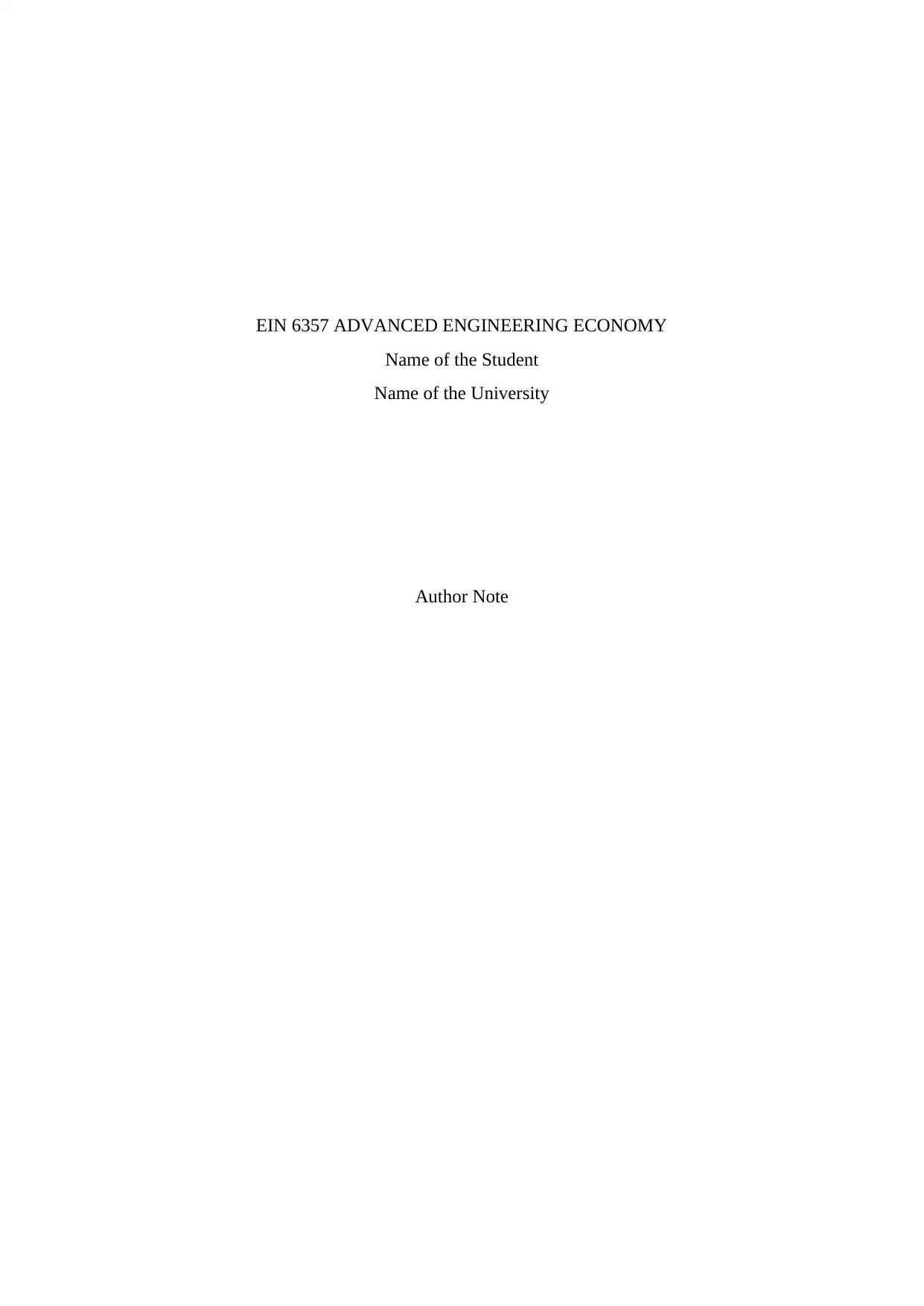
EIN 6357 ADVANCED ENGINEERING ECONOMY
Name of the Student
Name of the University
Author Note
Name of the Student
Name of the University
Author Note
Paraphrase This Document
Need a fresh take? Get an instant paraphrase of this document with our AI Paraphraser
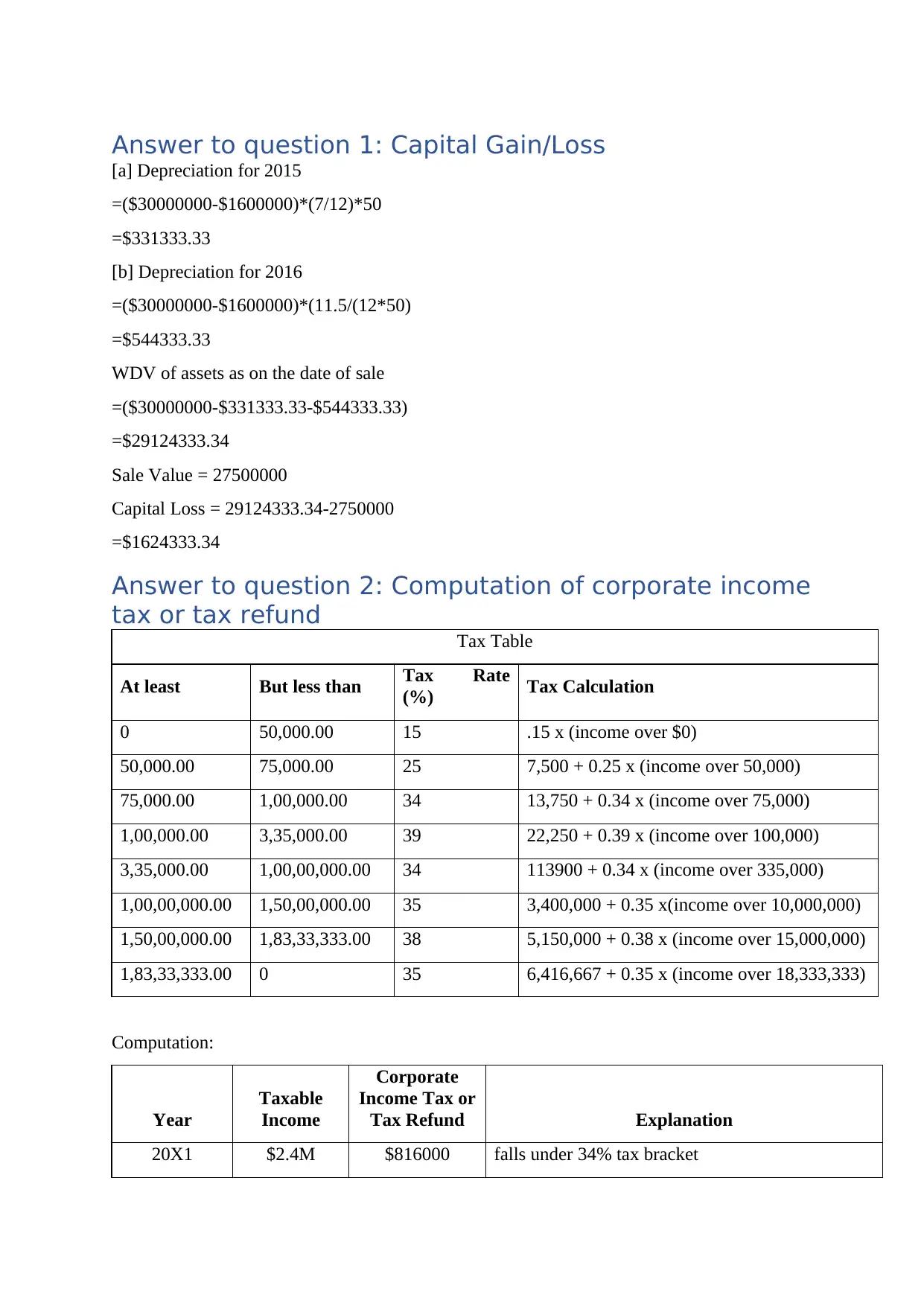
Answer to question 1: Capital Gain/Loss
[a] Depreciation for 2015
=($30000000-$1600000)*(7/12)*50
=$331333.33
[b] Depreciation for 2016
=($30000000-$1600000)*(11.5/(12*50)
=$544333.33
WDV of assets as on the date of sale
=($30000000-$331333.33-$544333.33)
=$29124333.34
Sale Value = 27500000
Capital Loss = 29124333.34-2750000
=$1624333.34
Answer to question 2: Computation of corporate income
tax or tax refund Tax Table
At least But less than Tax Rate
(%) Tax Calculation
0 50,000.00 15 .15 x (income over $0)
50,000.00 75,000.00 25 7,500 + 0.25 x (income over 50,000)
75,000.00 1,00,000.00 34 13,750 + 0.34 x (income over 75,000)
1,00,000.00 3,35,000.00 39 22,250 + 0.39 x (income over 100,000)
3,35,000.00 1,00,00,000.00 34 113900 + 0.34 x (income over 335,000)
1,00,00,000.00 1,50,00,000.00 35 3,400,000 + 0.35 x(income over 10,000,000)
1,50,00,000.00 1,83,33,333.00 38 5,150,000 + 0.38 x (income over 15,000,000)
1,83,33,333.00 0 35 6,416,667 + 0.35 x (income over 18,333,333)
Computation:
Year
Taxable
Income
Corporate
Income Tax or
Tax Refund Explanation
20X1 $2.4M $816000 falls under 34% tax bracket
[a] Depreciation for 2015
=($30000000-$1600000)*(7/12)*50
=$331333.33
[b] Depreciation for 2016
=($30000000-$1600000)*(11.5/(12*50)
=$544333.33
WDV of assets as on the date of sale
=($30000000-$331333.33-$544333.33)
=$29124333.34
Sale Value = 27500000
Capital Loss = 29124333.34-2750000
=$1624333.34
Answer to question 2: Computation of corporate income
tax or tax refund Tax Table
At least But less than Tax Rate
(%) Tax Calculation
0 50,000.00 15 .15 x (income over $0)
50,000.00 75,000.00 25 7,500 + 0.25 x (income over 50,000)
75,000.00 1,00,000.00 34 13,750 + 0.34 x (income over 75,000)
1,00,000.00 3,35,000.00 39 22,250 + 0.39 x (income over 100,000)
3,35,000.00 1,00,00,000.00 34 113900 + 0.34 x (income over 335,000)
1,00,00,000.00 1,50,00,000.00 35 3,400,000 + 0.35 x(income over 10,000,000)
1,50,00,000.00 1,83,33,333.00 38 5,150,000 + 0.38 x (income over 15,000,000)
1,83,33,333.00 0 35 6,416,667 + 0.35 x (income over 18,333,333)
Computation:
Year
Taxable
Income
Corporate
Income Tax or
Tax Refund Explanation
20X1 $2.4M $816000 falls under 34% tax bracket
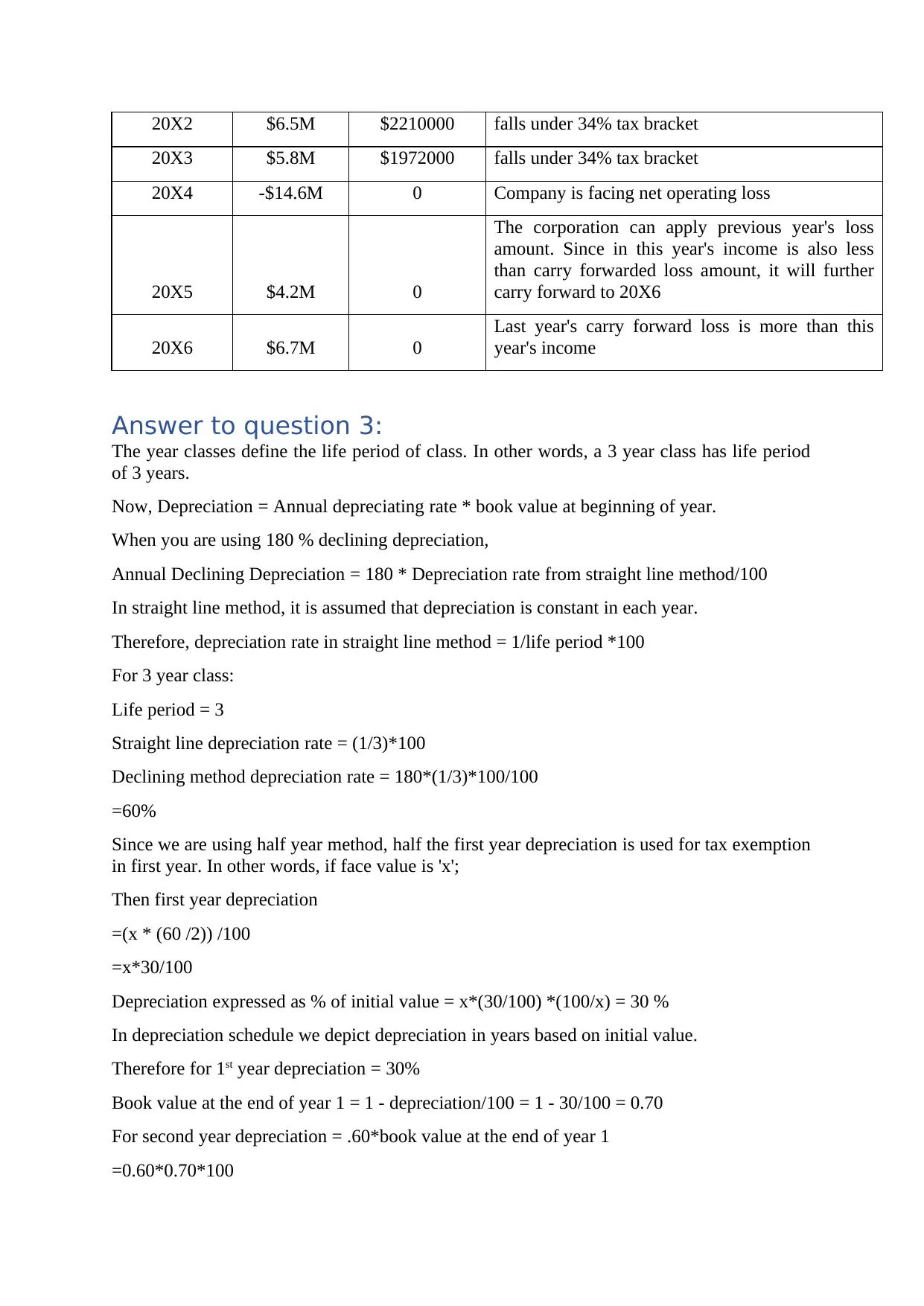
20X2 $6.5M $2210000 falls under 34% tax bracket
20X3 $5.8M $1972000 falls under 34% tax bracket
20X4 -$14.6M 0 Company is facing net operating loss
20X5 $4.2M 0
The corporation can apply previous year's loss
amount. Since in this year's income is also less
than carry forwarded loss amount, it will further
carry forward to 20X6
20X6 $6.7M 0
Last year's carry forward loss is more than this
year's income
Answer to question 3:
The year classes define the life period of class. In other words, a 3 year class has life period
of 3 years.
Now, Depreciation = Annual depreciating rate * book value at beginning of year.
When you are using 180 % declining depreciation,
Annual Declining Depreciation = 180 * Depreciation rate from straight line method/100
In straight line method, it is assumed that depreciation is constant in each year.
Therefore, depreciation rate in straight line method = 1/life period *100
For 3 year class:
Life period = 3
Straight line depreciation rate = (1/3)*100
Declining method depreciation rate = 180*(1/3)*100/100
=60%
Since we are using half year method, half the first year depreciation is used for tax exemption
in first year. In other words, if face value is 'x';
Then first year depreciation
=(x * (60 /2)) /100
=x*30/100
Depreciation expressed as % of initial value = x*(30/100) *(100/x) = 30 %
In depreciation schedule we depict depreciation in years based on initial value.
Therefore for 1st year depreciation = 30%
Book value at the end of year 1 = 1 - depreciation/100 = 1 - 30/100 = 0.70
For second year depreciation = .60*book value at the end of year 1
=0.60*0.70*100
20X3 $5.8M $1972000 falls under 34% tax bracket
20X4 -$14.6M 0 Company is facing net operating loss
20X5 $4.2M 0
The corporation can apply previous year's loss
amount. Since in this year's income is also less
than carry forwarded loss amount, it will further
carry forward to 20X6
20X6 $6.7M 0
Last year's carry forward loss is more than this
year's income
Answer to question 3:
The year classes define the life period of class. In other words, a 3 year class has life period
of 3 years.
Now, Depreciation = Annual depreciating rate * book value at beginning of year.
When you are using 180 % declining depreciation,
Annual Declining Depreciation = 180 * Depreciation rate from straight line method/100
In straight line method, it is assumed that depreciation is constant in each year.
Therefore, depreciation rate in straight line method = 1/life period *100
For 3 year class:
Life period = 3
Straight line depreciation rate = (1/3)*100
Declining method depreciation rate = 180*(1/3)*100/100
=60%
Since we are using half year method, half the first year depreciation is used for tax exemption
in first year. In other words, if face value is 'x';
Then first year depreciation
=(x * (60 /2)) /100
=x*30/100
Depreciation expressed as % of initial value = x*(30/100) *(100/x) = 30 %
In depreciation schedule we depict depreciation in years based on initial value.
Therefore for 1st year depreciation = 30%
Book value at the end of year 1 = 1 - depreciation/100 = 1 - 30/100 = 0.70
For second year depreciation = .60*book value at the end of year 1
=0.60*0.70*100
⊘ This is a preview!⊘
Do you want full access?
Subscribe today to unlock all pages.

Trusted by 1+ million students worldwide
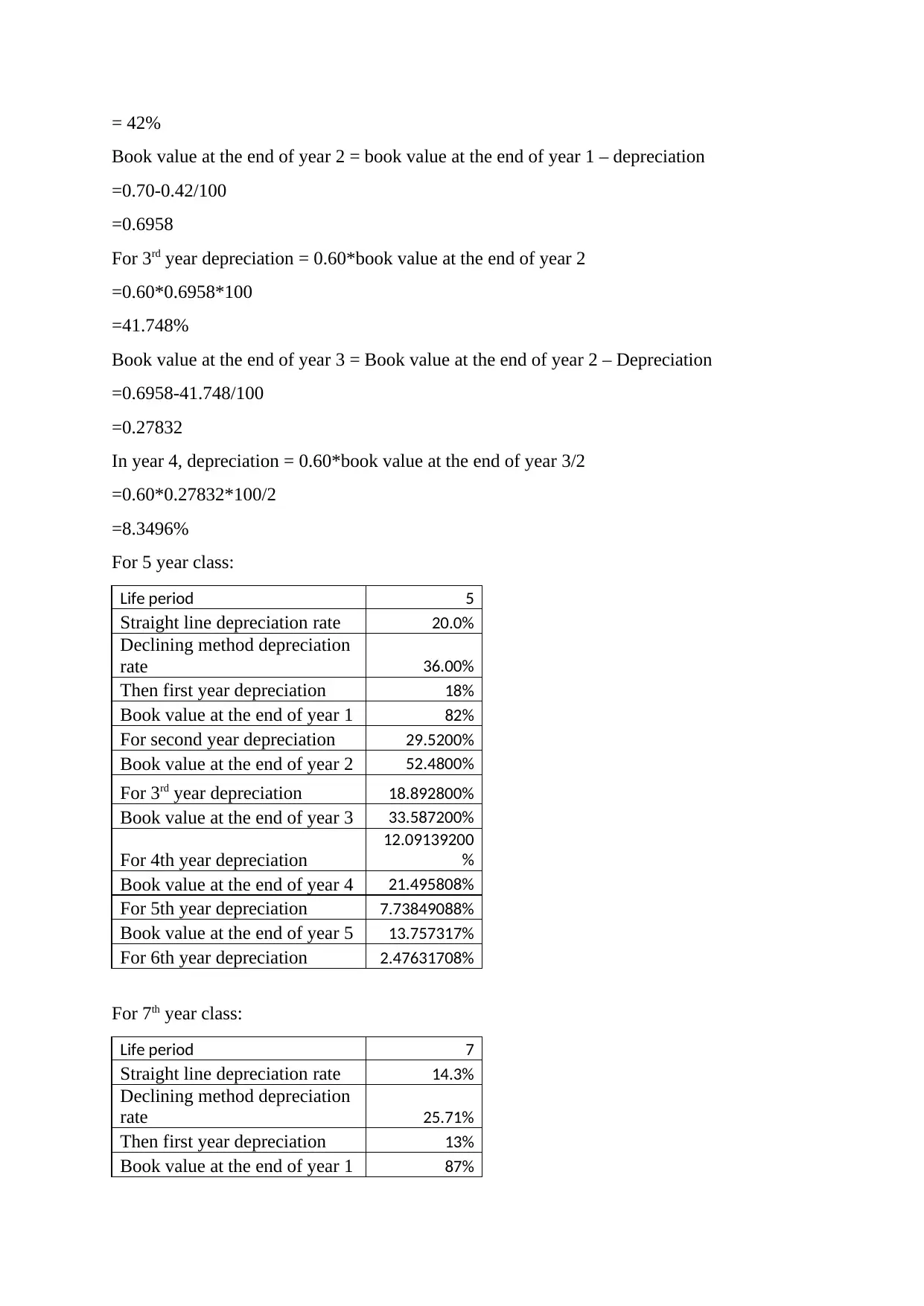
= 42%
Book value at the end of year 2 = book value at the end of year 1 – depreciation
=0.70-0.42/100
=0.6958
For 3rd year depreciation = 0.60*book value at the end of year 2
=0.60*0.6958*100
=41.748%
Book value at the end of year 3 = Book value at the end of year 2 – Depreciation
=0.6958-41.748/100
=0.27832
In year 4, depreciation = 0.60*book value at the end of year 3/2
=0.60*0.27832*100/2
=8.3496%
For 5 year class:
Life period 5
Straight line depreciation rate 20.0%
Declining method depreciation
rate 36.00%
Then first year depreciation 18%
Book value at the end of year 1 82%
For second year depreciation 29.5200%
Book value at the end of year 2 52.4800%
For 3rd year depreciation 18.892800%
Book value at the end of year 3 33.587200%
For 4th year depreciation
12.09139200
%
Book value at the end of year 4 21.495808%
For 5th year depreciation 7.73849088%
Book value at the end of year 5 13.757317%
For 6th year depreciation 2.47631708%
For 7th year class:
Life period 7
Straight line depreciation rate 14.3%
Declining method depreciation
rate 25.71%
Then first year depreciation 13%
Book value at the end of year 1 87%
Book value at the end of year 2 = book value at the end of year 1 – depreciation
=0.70-0.42/100
=0.6958
For 3rd year depreciation = 0.60*book value at the end of year 2
=0.60*0.6958*100
=41.748%
Book value at the end of year 3 = Book value at the end of year 2 – Depreciation
=0.6958-41.748/100
=0.27832
In year 4, depreciation = 0.60*book value at the end of year 3/2
=0.60*0.27832*100/2
=8.3496%
For 5 year class:
Life period 5
Straight line depreciation rate 20.0%
Declining method depreciation
rate 36.00%
Then first year depreciation 18%
Book value at the end of year 1 82%
For second year depreciation 29.5200%
Book value at the end of year 2 52.4800%
For 3rd year depreciation 18.892800%
Book value at the end of year 3 33.587200%
For 4th year depreciation
12.09139200
%
Book value at the end of year 4 21.495808%
For 5th year depreciation 7.73849088%
Book value at the end of year 5 13.757317%
For 6th year depreciation 2.47631708%
For 7th year class:
Life period 7
Straight line depreciation rate 14.3%
Declining method depreciation
rate 25.71%
Then first year depreciation 13%
Book value at the end of year 1 87%
Paraphrase This Document
Need a fresh take? Get an instant paraphrase of this document with our AI Paraphraser
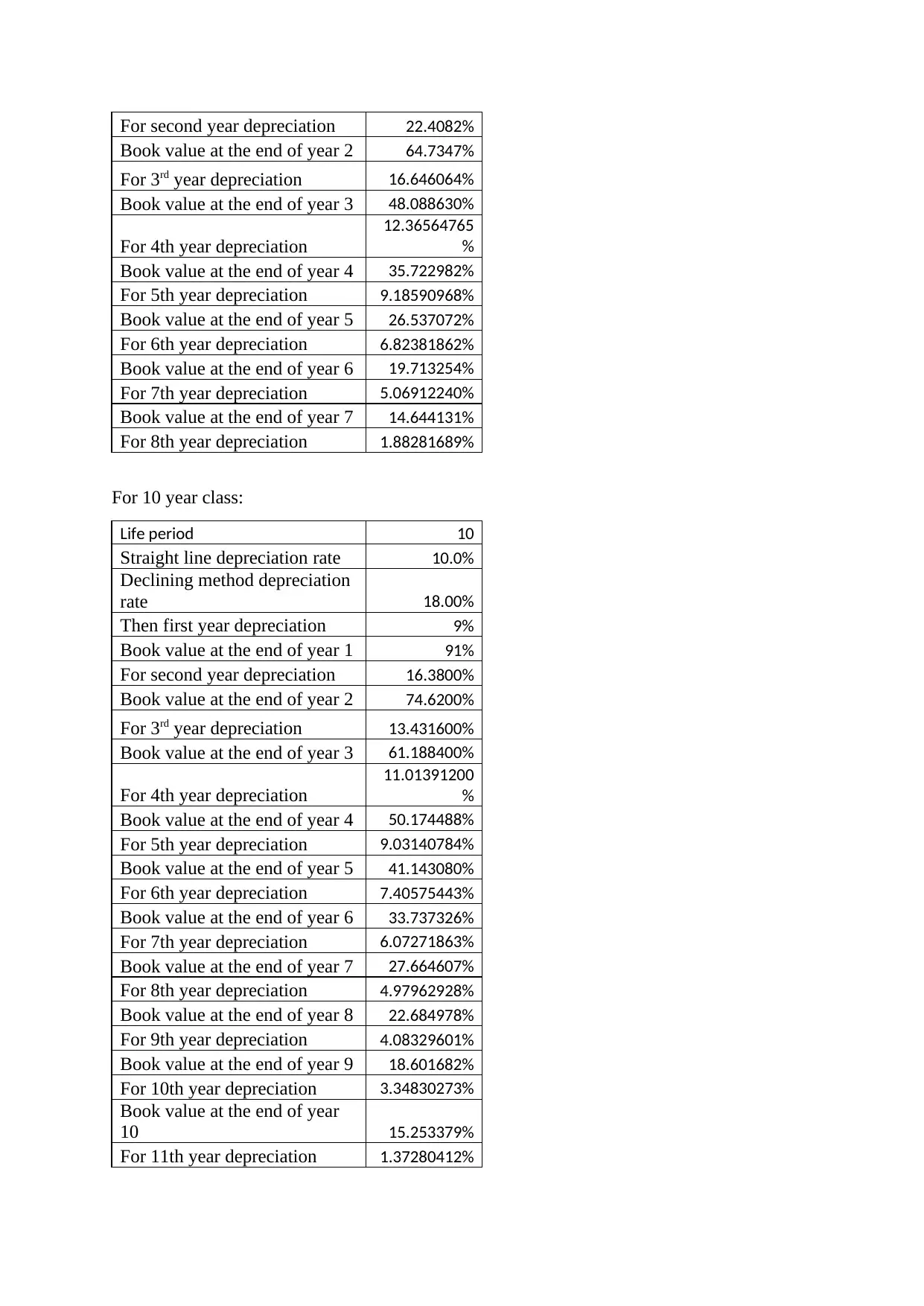
For second year depreciation 22.4082%
Book value at the end of year 2 64.7347%
For 3rd year depreciation 16.646064%
Book value at the end of year 3 48.088630%
For 4th year depreciation
12.36564765
%
Book value at the end of year 4 35.722982%
For 5th year depreciation 9.18590968%
Book value at the end of year 5 26.537072%
For 6th year depreciation 6.82381862%
Book value at the end of year 6 19.713254%
For 7th year depreciation 5.06912240%
Book value at the end of year 7 14.644131%
For 8th year depreciation 1.88281689%
For 10 year class:
Life period 10
Straight line depreciation rate 10.0%
Declining method depreciation
rate 18.00%
Then first year depreciation 9%
Book value at the end of year 1 91%
For second year depreciation 16.3800%
Book value at the end of year 2 74.6200%
For 3rd year depreciation 13.431600%
Book value at the end of year 3 61.188400%
For 4th year depreciation
11.01391200
%
Book value at the end of year 4 50.174488%
For 5th year depreciation 9.03140784%
Book value at the end of year 5 41.143080%
For 6th year depreciation 7.40575443%
Book value at the end of year 6 33.737326%
For 7th year depreciation 6.07271863%
Book value at the end of year 7 27.664607%
For 8th year depreciation 4.97962928%
Book value at the end of year 8 22.684978%
For 9th year depreciation 4.08329601%
Book value at the end of year 9 18.601682%
For 10th year depreciation 3.34830273%
Book value at the end of year
10 15.253379%
For 11th year depreciation 1.37280412%
Book value at the end of year 2 64.7347%
For 3rd year depreciation 16.646064%
Book value at the end of year 3 48.088630%
For 4th year depreciation
12.36564765
%
Book value at the end of year 4 35.722982%
For 5th year depreciation 9.18590968%
Book value at the end of year 5 26.537072%
For 6th year depreciation 6.82381862%
Book value at the end of year 6 19.713254%
For 7th year depreciation 5.06912240%
Book value at the end of year 7 14.644131%
For 8th year depreciation 1.88281689%
For 10 year class:
Life period 10
Straight line depreciation rate 10.0%
Declining method depreciation
rate 18.00%
Then first year depreciation 9%
Book value at the end of year 1 91%
For second year depreciation 16.3800%
Book value at the end of year 2 74.6200%
For 3rd year depreciation 13.431600%
Book value at the end of year 3 61.188400%
For 4th year depreciation
11.01391200
%
Book value at the end of year 4 50.174488%
For 5th year depreciation 9.03140784%
Book value at the end of year 5 41.143080%
For 6th year depreciation 7.40575443%
Book value at the end of year 6 33.737326%
For 7th year depreciation 6.07271863%
Book value at the end of year 7 27.664607%
For 8th year depreciation 4.97962928%
Book value at the end of year 8 22.684978%
For 9th year depreciation 4.08329601%
Book value at the end of year 9 18.601682%
For 10th year depreciation 3.34830273%
Book value at the end of year
10 15.253379%
For 11th year depreciation 1.37280412%
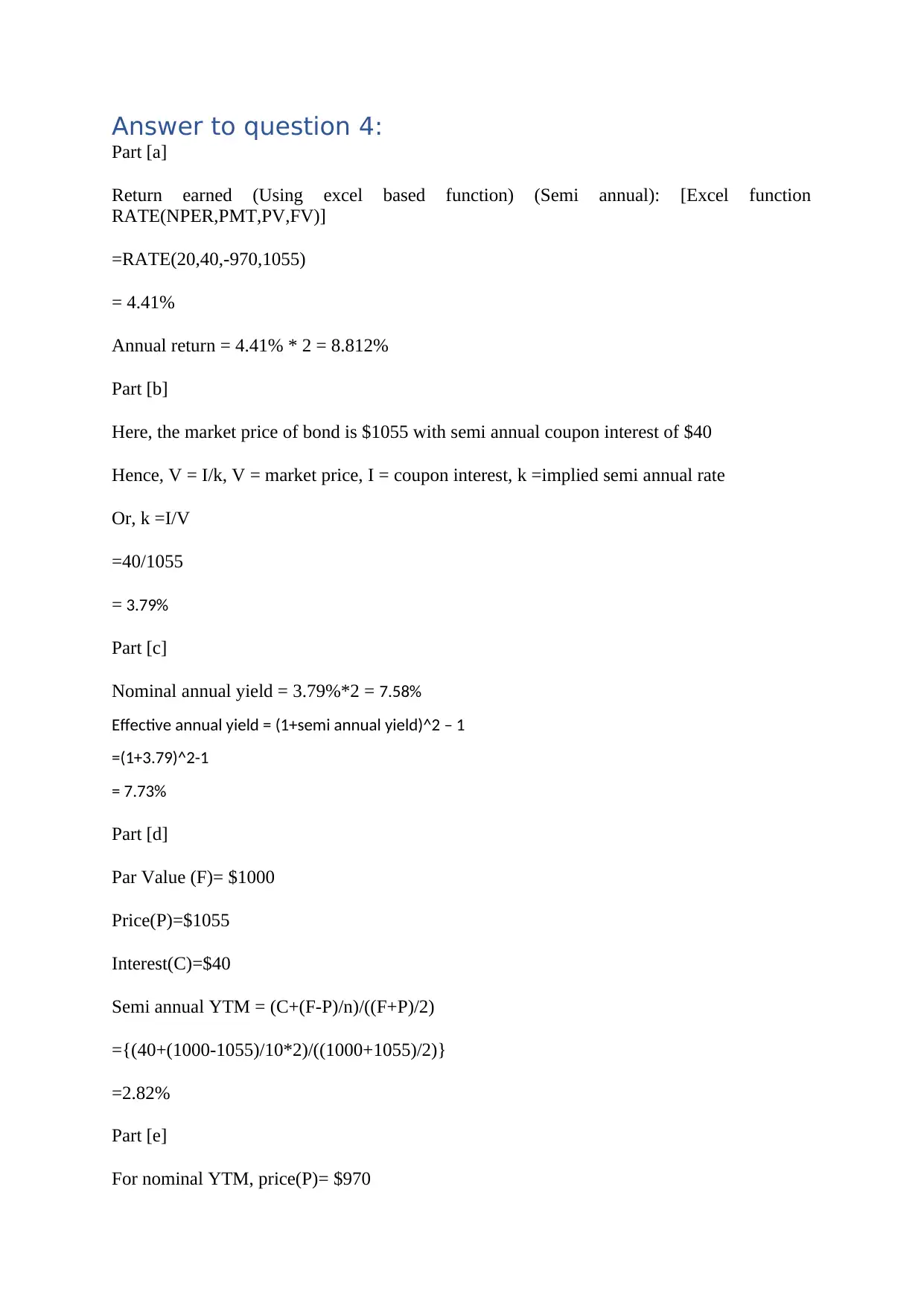
Answer to question 4:
Part [a]
Return earned (Using excel based function) (Semi annual): [Excel function
RATE(NPER,PMT,PV,FV)]
=RATE(20,40,-970,1055)
= 4.41%
Annual return = 4.41% * 2 = 8.812%
Part [b]
Here, the market price of bond is $1055 with semi annual coupon interest of $40
Hence, V = I/k, V = market price, I = coupon interest, k =implied semi annual rate
Or, k =I/V
=40/1055
= 3.79%
Part [c]
Nominal annual yield = 3.79%*2 = 7.58%
Effective annual yield = (1+semi annual yield)^2 – 1
=(1+3.79)^2-1
= 7.73%
Part [d]
Par Value (F)= $1000
Price(P)=$1055
Interest(C)=$40
Semi annual YTM = (C+(F-P)/n)/((F+P)/2)
={(40+(1000-1055)/10*2)/((1000+1055)/2)}
=2.82%
Part [e]
For nominal YTM, price(P)= $970
Part [a]
Return earned (Using excel based function) (Semi annual): [Excel function
RATE(NPER,PMT,PV,FV)]
=RATE(20,40,-970,1055)
= 4.41%
Annual return = 4.41% * 2 = 8.812%
Part [b]
Here, the market price of bond is $1055 with semi annual coupon interest of $40
Hence, V = I/k, V = market price, I = coupon interest, k =implied semi annual rate
Or, k =I/V
=40/1055
= 3.79%
Part [c]
Nominal annual yield = 3.79%*2 = 7.58%
Effective annual yield = (1+semi annual yield)^2 – 1
=(1+3.79)^2-1
= 7.73%
Part [d]
Par Value (F)= $1000
Price(P)=$1055
Interest(C)=$40
Semi annual YTM = (C+(F-P)/n)/((F+P)/2)
={(40+(1000-1055)/10*2)/((1000+1055)/2)}
=2.82%
Part [e]
For nominal YTM, price(P)= $970
⊘ This is a preview!⊘
Do you want full access?
Subscribe today to unlock all pages.

Trusted by 1+ million students worldwide
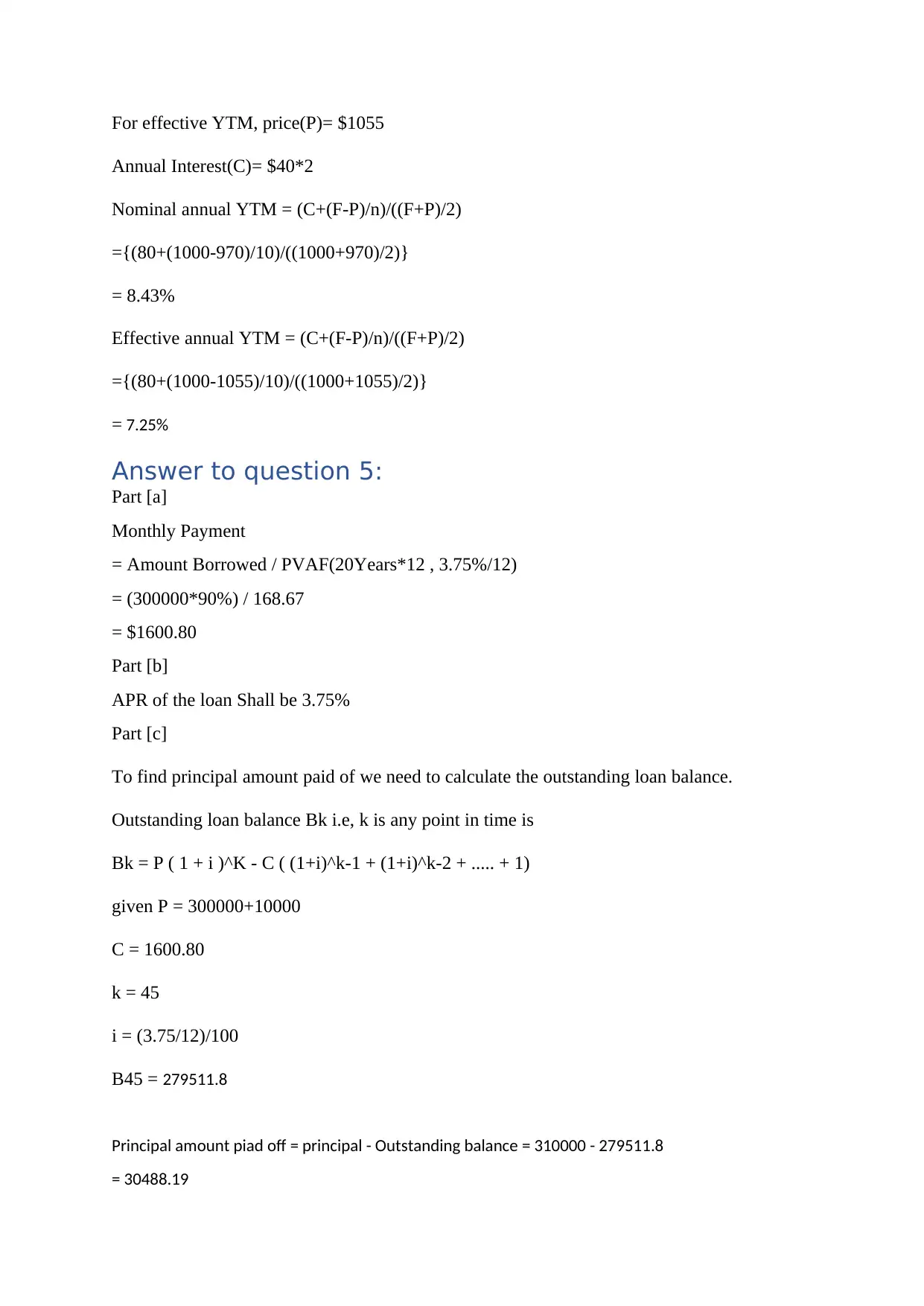
For effective YTM, price(P)= $1055
Annual Interest(C)= $40*2
Nominal annual YTM = (C+(F-P)/n)/((F+P)/2)
={(80+(1000-970)/10)/((1000+970)/2)}
= 8.43%
Effective annual YTM = (C+(F-P)/n)/((F+P)/2)
={(80+(1000-1055)/10)/((1000+1055)/2)}
= 7.25%
Answer to question 5:
Part [a]
Monthly Payment
= Amount Borrowed / PVAF(20Years*12 , 3.75%/12)
= (300000*90%) / 168.67
= $1600.80
Part [b]
APR of the loan Shall be 3.75%
Part [c]
To find principal amount paid of we need to calculate the outstanding loan balance.
Outstanding loan balance Bk i.e, k is any point in time is
Bk = P ( 1 + i )^K - C ( (1+i)^k-1 + (1+i)^k-2 + ..... + 1)
given P = 300000+10000
C = 1600.80
k = 45
i = (3.75/12)/100
B45 = 279511.8
Principal amount piad off = principal - Outstanding balance = 310000 - 279511.8
= 30488.19
Annual Interest(C)= $40*2
Nominal annual YTM = (C+(F-P)/n)/((F+P)/2)
={(80+(1000-970)/10)/((1000+970)/2)}
= 8.43%
Effective annual YTM = (C+(F-P)/n)/((F+P)/2)
={(80+(1000-1055)/10)/((1000+1055)/2)}
= 7.25%
Answer to question 5:
Part [a]
Monthly Payment
= Amount Borrowed / PVAF(20Years*12 , 3.75%/12)
= (300000*90%) / 168.67
= $1600.80
Part [b]
APR of the loan Shall be 3.75%
Part [c]
To find principal amount paid of we need to calculate the outstanding loan balance.
Outstanding loan balance Bk i.e, k is any point in time is
Bk = P ( 1 + i )^K - C ( (1+i)^k-1 + (1+i)^k-2 + ..... + 1)
given P = 300000+10000
C = 1600.80
k = 45
i = (3.75/12)/100
B45 = 279511.8
Principal amount piad off = principal - Outstanding balance = 310000 - 279511.8
= 30488.19
Paraphrase This Document
Need a fresh take? Get an instant paraphrase of this document with our AI Paraphraser
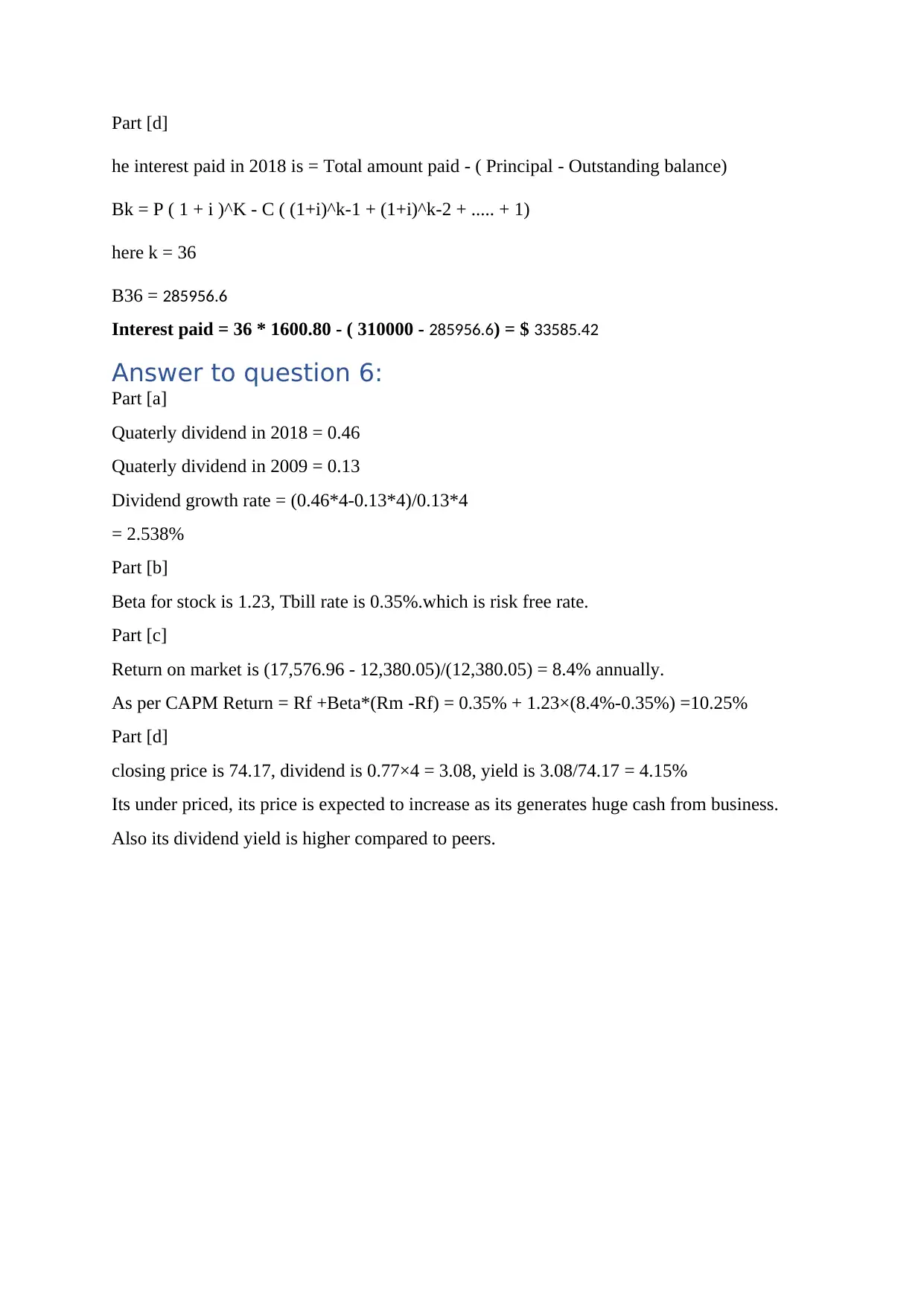
Part [d]
he interest paid in 2018 is = Total amount paid - ( Principal - Outstanding balance)
Bk = P ( 1 + i )^K - C ( (1+i)^k-1 + (1+i)^k-2 + ..... + 1)
here k = 36
B36 = 285956.6
Interest paid = 36 * 1600.80 - ( 310000 - 285956.6) = $ 33585.42
Answer to question 6:
Part [a]
Quaterly dividend in 2018 = 0.46
Quaterly dividend in 2009 = 0.13
Dividend growth rate = (0.46*4-0.13*4)/0.13*4
= 2.538%
Part [b]
Beta for stock is 1.23, Tbill rate is 0.35%.which is risk free rate.
Part [c]
Return on market is (17,576.96 - 12,380.05)/(12,380.05) = 8.4% annually.
As per CAPM Return = Rf +Beta*(Rm -Rf) = 0.35% + 1.23×(8.4%-0.35%) =10.25%
Part [d]
closing price is 74.17, dividend is 0.77×4 = 3.08, yield is 3.08/74.17 = 4.15%
Its under priced, its price is expected to increase as its generates huge cash from business.
Also its dividend yield is higher compared to peers.
he interest paid in 2018 is = Total amount paid - ( Principal - Outstanding balance)
Bk = P ( 1 + i )^K - C ( (1+i)^k-1 + (1+i)^k-2 + ..... + 1)
here k = 36
B36 = 285956.6
Interest paid = 36 * 1600.80 - ( 310000 - 285956.6) = $ 33585.42
Answer to question 6:
Part [a]
Quaterly dividend in 2018 = 0.46
Quaterly dividend in 2009 = 0.13
Dividend growth rate = (0.46*4-0.13*4)/0.13*4
= 2.538%
Part [b]
Beta for stock is 1.23, Tbill rate is 0.35%.which is risk free rate.
Part [c]
Return on market is (17,576.96 - 12,380.05)/(12,380.05) = 8.4% annually.
As per CAPM Return = Rf +Beta*(Rm -Rf) = 0.35% + 1.23×(8.4%-0.35%) =10.25%
Part [d]
closing price is 74.17, dividend is 0.77×4 = 3.08, yield is 3.08/74.17 = 4.15%
Its under priced, its price is expected to increase as its generates huge cash from business.
Also its dividend yield is higher compared to peers.
1 out of 8
Your All-in-One AI-Powered Toolkit for Academic Success.
+13062052269
info@desklib.com
Available 24*7 on WhatsApp / Email
![[object Object]](/_next/static/media/star-bottom.7253800d.svg)
Unlock your academic potential
Copyright © 2020–2025 A2Z Services. All Rights Reserved. Developed and managed by ZUCOL.

